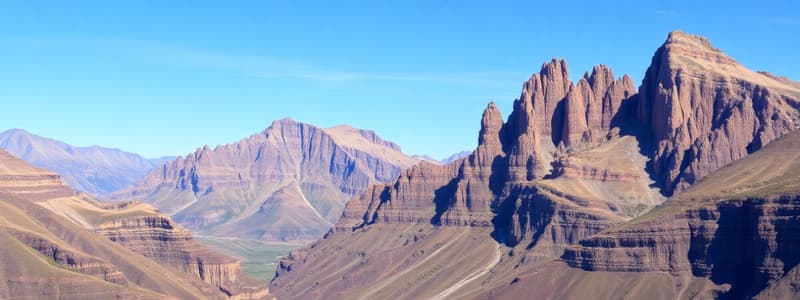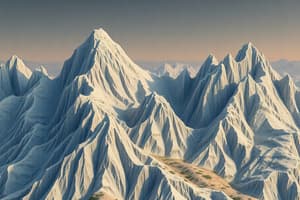Podcast
Questions and Answers
Which geological process is most directly responsible for the creation of fold mountains?
Which geological process is most directly responsible for the creation of fold mountains?
- The gradual accumulation of sediment in sedimentary basins.
- The collision and compression of tectonic plates at convergent boundaries. (correct)
- Erosion caused by wind and water over millions of years.
- Volcanic eruptions along divergent plate boundaries.
When two continental plates collide, which of the following geological features is most likely to occur?
When two continental plates collide, which of the following geological features is most likely to occur?
- A deep ocean trench.
- A volcanic island arc.
- A mid-ocean ridge.
- A large fold mountain range. (correct)
In the formation of fold mountains at an oceanic-continental convergent boundary, what process occurs?
In the formation of fold mountains at an oceanic-continental convergent boundary, what process occurs?
- The two plates slide past each other, creating a transform fault.
- The two plates move apart, allowing for seafloor spreading.
- The oceanic plate subducts beneath the continental plate. (correct)
- The continental plate subducts beneath the oceanic plate.
Which of the following best describes the sequence of events in the formation of fold mountains?
Which of the following best describes the sequence of events in the formation of fold mountains?
What is the primary force that causes the Earth's crust to crumple and fold during the formation of fold mountains?
What is the primary force that causes the Earth's crust to crumple and fold during the formation of fold mountains?
If you observe a geological formation with upward-arching folds, how would you classify these folds?
If you observe a geological formation with upward-arching folds, how would you classify these folds?
Which mountain range was formed by the collision of the Indian Plate with the Eurasian Plate?
Which mountain range was formed by the collision of the Indian Plate with the Eurasian Plate?
How do overturned folds differ from typical anticlines and synclines?
How do overturned folds differ from typical anticlines and synclines?
Flashcards
Fold Mountains
Fold Mountains
Mountains formed by the crumpling and folding of the Earth's crust due to tectonic plate collisions.
Plate Tectonics
Plate Tectonics
The theory that the Earth's lithosphere is divided into plates that move and interact, causing geological events.
Convergent Plate Boundary
Convergent Plate Boundary
Boundary where two tectonic plates collide.
Continental-Continental Collision
Continental-Continental Collision
Signup and view all the flashcards
Subduction
Subduction
Signup and view all the flashcards
Compression
Compression
Signup and view all the flashcards
Anticlines
Anticlines
Signup and view all the flashcards
Synclines
Synclines
Signup and view all the flashcards
Study Notes
- Fold mountains are natural structures formed through a geological process involving the movement of lithospheric plates.
Plate Tectonics
- The Earth's lithosphere is divided into tectonic plates that float on the asthenosphere.
- Plate movement causes interactions at boundaries, leading to geological features, including fold mountains.
Convergent Plate Boundaries
- Fold mountains primarily form at convergent plate boundaries.
- This is where two tectonic plates collide.
- Continental-Continental Plates: When two continental plates collide, they push against each other, causing the land to buckle and fold.
- This collision results in the formation of large fold mountain ranges, such as the Himalayas.
- Oceanic-Continental Plates: When an oceanic plate collides with a continental plate, the denser oceanic plate is forced underneath the continental plate in subduction.
- Subduction can result in the formation of fold mountains on the edge of the continent, such as the Andes in South America.
Folding Process
- When tectonic plates collide, pressure and forces cause the Earth's crust to crumple and fold.
- Compression: The collision of tectonic plates exerts compressional forces on rocks in the Earth's crust, pushing them together.
- Folding: Compressional forces cause rock layers to bend, creating upward and downward folds, ranging from small wrinkles to massive mountain ranges.
- Uplift: As folding continues, the crust is uplifted, forming mountain peaks and ranges.
Types of Folds
- Folds are classified based on appearance and structure.
- Anticlines: Upward-arching folds.
- Synclines: Downward, trough-like folds.
- Overturned Folds: Folds pushed over by intense pressure, often appearing to lean or tilt.
Examples of Fold Mountains
- The Himalayas are formed via collision of the Indian Plate with the Eurasian Plate.
- The Alps are a result of the collision between the African Plate and the Eurasian Plate.
- The Rockies are formed by the subduction of the Pacific Plate beneath the North American Plate.
Studying That Suits You
Use AI to generate personalized quizzes and flashcards to suit your learning preferences.




